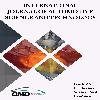Thermodynamic Analysis of a Renewable Energy-Driven Electric Vehicle Charging Station with On-Site Electricity Generation from Hydrogen and Ammonia Fuel Cells
The vast implementation of electric vehicles (EVs) greatly depends on developing sustainable and green EV charging stations. This study pro-poses to develop and assess an off-grid and renewable energy-driven EV charging station, which is hybridized with hydrogen and ammonia fuel cells. Chemical energies of hydrogen and ammonia are stored in the stor-age tanks to be used in the hydrogen and ammonia fuel cells. The de-signed hybrid system is capable of storing energy in the chemical form when there is excess production. Ammonia is stored in liquid form rather than gaseous form, which reduces the storage tank capacity considerably and decreases the losses. The designed system, which includes a wind turbine, concentrated photovoltaic (CPV) and fuel cells, can produce about 1.1 MW of power and 15.46 MWh of electricity in a single day, corresponding to about 294 number of EVs. In addition, the hybrid sys-tem can charge up to 644 EVs if the ammonia feed rate is increased to 0.1 kg/s. The fuel cells are capable of generating about 80% of the charging station. The effects of important key parameters such as wind speed, so-lar irradiance and fuel supply rates are investigated to observe the im-pacts on the overall system.
Keywords:
Electric vehicle, thermodynamics, solar energy, wind energy energy storage,
___
- [1] Bicer Y, Dincer I. Life cycle environmental impact assessments and comparisons of alternative fuels for clean vehicles. Resour Conserv Recycl 2018. doi:10.1016/j.resconrec.2018.01.036.
- [2] Girard A, Roberts C, Simon F, Ordoñez J. Solar electricity production and taxi electrical vehicle conversion in Chile. J Clean Prod 2019;210:1261–9. doi:10.1016/j.jclepro.2018.11.092.
- [3] Ghenai C, Bettayeb M. Modelling and performance analysis of a stand-alone hybrid solar PV/Fuel Cell/Diesel Generator power system for university building. Energy 2019;171:180–9. doi:10.1016/j.energy.2019.01.019.
- [4] Mozafar MR, Moradi MH, Amini MH. A simultaneous approach for optimal allocation of renewable energy sources and electric vehicle charging stations in smart grids based on improved GA-PSO algorithm. Sustain Cities Soc 2017;32:627–37. doi:10.1016/J.SCS.2017.05.007.
- [5] Amjad M, Ahmad A, Rehmani MH, Umer T. A review of EVs charging: From the perspective of energy optimization, optimization approaches, and charging techniques. Transp Res Part D Transp Environ 2018;62:386–417. doi:10.1016/j.trd.2018.03.006.
- [6] Fazelpour F, Vafaeipour M, Rahbari O, Rosen MA. Intelligent optimization to integrate a plug-in hybrid electric vehicle smart parking lot with renewable energy resources and enhance grid characteristics. Energy Convers Manag 2014;77:250–61. doi:10.1016/j.enconman.2013.09.006.
- [7] Karmaker AK, Ahmed MR, Hossain MA, Sikder MM. Feasibility assessment & design of hybrid renewable energy based electric vehicle charging station in Bangladesh. Sustain Cities Soc 2018;39:189–202. doi:10.1016/j.scs.2018.02.035.
- [8] Grande LSA, Yahyaoui I, Gómez SA. Energetic, economic and environmental viability of off-grid PV-BESS for charging electric vehicles: Case study of Spain. Sustain Cities Soc 2018;37:519–29. doi:10.1016/J.SCS.2017.12.009.
- [9] Dicks G, Breedon F. World Outlook. vol. 12. 2013th ed. International Energy Agency (IEA),; 1988. doi:10.1111/j.1468-0319.1988.tb00400.x.
- [10] García-Villalobos J, Zamora I, San Martín JI, Asensio FJ, Aperribay V. Plug-in electric vehicles in electric distribution networks: A review of smart charging approaches. Renew Sustain Energy Rev 2014;38:717–31. doi:10.1016/j.rser.2014.07.040.
- [11] Amini MH, Boroojeni KG, Cheng Jian Wang, Nejadpak A, Iyengar SS, Karabasoglu O. Effect of electric vehicle parking lots’ charging demand as dispatchable loads on power systems loss. 2016 IEEE Int. Conf. Electro Inf. Technol., IEEE; 2016, p. 0499–503. doi:10.1109/EIT.2016.7535291.
- [12] Zhang Y, He Y, Wang X, Wang Y, Fang C, Xue H, et al. Modeling of fast charging station equipped with energy storage. Glob Energy Interconnect 2019;1:145–52. doi:.1037//0033-2909.I26.1.78.
- [13] Razipour R, Moghaddas-Tafreshi SM, Farhadi P. Optimal management of electric vehicles in an intelligent parking lot in the presence of hydrogen storage system. J Energy Storage 2019;22:144–52. doi:10.1016/j.est.2019.02.001.
- [14] Wu D, Radhakrishnan N, Huang S. A hierarchical charging control of plug-in electric vehicles with simple flexibility model. Appl Energy 2019;253:113490. doi:10.1016/j.apenergy.2019.113490.
- [15] Goli P, Shireen W. PV powered smart charging station for PHEVs. Renew Energy 2014;66:280–7. doi:10.1016/j.renene.2013.11.066.
- [16] Caliskan H, Dincer I, Hepbasli A. Exergoeconomic and environmental impact analyses of a renewable energy based hydrogen production system. Int J Hydrogen Energy 2013;38:6104–11. doi:10.1016/j.ijhydene.2013.01.069.
- [17] Ramadhani F, Hussain MA, Mokhlis H, Fazly M, Ali JM. Evaluation of solid oxide fuel cell based polygeneration system in residential areas integrating with electric charging and hydrogen fueling stations for vehicles. Appl Energy 2019;238:1373–88. doi:10.1016/j.apenergy.2019.01.150.
- [18] Rabbani M, Dincer I, Naterer GF. Thermodynamic assessment of a wind turbine based combined cycle. Energy 2012;44:321–8. doi:10.1016/j.energy.2012.06.027.
- [19] Caduff M, Huijbregts MAJ, Althaus H-J, Koehler A, Hellweg S. Wind Power Electricity: The Bigger the Turbine, The Greener the Electricity? Environ Sci Technol 2012;46:4725–33. doi:10.1021/es204108n.
- [20] Notton G. Hybrid wind-photovoltaic energy systems. Stand-Alone Hybrid Wind Energy Syst., Elsevier; 2010, p. 216–53. doi:10.1533/9781845699628.2.216.
- [21] Software F-C, Software. Engineering Equations Solver 2018.
- Yayın Aralığı: Yılda 4 Sayı
- Başlangıç: 2016
- Yayıncı: Otomotiv Mühendisleri Derneği
Sayıdaki Diğer Makaleler
Hüseyin BAYRAKÇEKEN, Faruk Emre AYSAL, Hicri YAVUZ
Fatih KARPAT, Oğuz DOĞAN, Onur Can KALAY, Emirhan KARTAL
Sedef KÖSE, Gizemnur AYLANŞIK, Mustafa BABABGİRAY, Tolga KOCAKULAK
